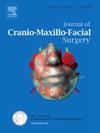颅骨发育不良患者使用牵张成骨法进行眶前推进和重塑的长期效果。
IF 2.1
2区 医学
Q2 DENTISTRY, ORAL SURGERY & MEDICINE
引用次数: 0
摘要
在描述眶前牵引技术的最初报告中,推进骨段时保留了骨段与硬脑膜的连接。这种方法无法对额骨部分进行重塑。然而,在本文描述的技术中,前眶部分与硬脑膜分离、重塑,并使用牵引器作为骨移植推进。我们对 27 名接受了牵张成骨法前眶推进和重塑手术的颅骨发育不良患者进行了回顾性研究。手术时的平均年龄为(19.03 ± 9.19)个月;平均随访时间为(86.04 ± 34.98)个月。平均牵引量超过 19 毫米。大脑皮层和髓质的额骨和枕骨骨密度测量结果无明显差异。骨缺损的平均总面积为 4.79 ± 4.43 平方厘米,骨缺损的平均数量为 4.8 ± 2.2。头颅指数从(98.56 ± 6.39)下降到(87.63 ± 4.54),59.3%的患者在术后后期达到了正常范围。使用牵引成骨法进行前眶推进和重塑似乎是安全有效的。牵引额骨作为移植物不会导致骨吸收,而且可以形成新骨并改善头型。本文章由计算机程序翻译,如有差异,请以英文原文为准。
Long-term results of fronto-orbital advancement and remodeling using distraction osteogenesis in craniosynostosis patients
In the initial report describing the fronto-orbital distraction technique, bone segments were advanced preserving their attachments with the dura. This approach does not allow for the remodeling of the frontal segment. However, in the technique described herein, the fronto-orbital segment is separated from dura, remodeled, and advanced as a bone graft using distractors. Twenty-seven craniosynostosis patients that underwent fronto-orbital advancement and remodeling using distraction osteogenesis were retrospectively reviewed. The mean age at the time of surgery was 19.03 ± 9.19 months; the mean follow-up was 86.04 ± 34.98 months. The mean distraction amount was over 19 mm. No significant difference was found between frontal and occipital bone density measurements at the cortex and medulla. The mean total defect area was 4.79 ± 4.43 cm2 and the mean number of bone defects was 4.8 ± 2.2. The cephalic index decreased from 98.56 ± 6.39 to 87.63 ± 4.54, and 59.3% of the patients reached the normal range in the late postoperative period. Fronto-orbital advancement and remodeling using distraction osteogenesis appears to be safe and effective. Distraction of the frontal bone as a graft does not lead to bone resorption, and new bone formation and improvements in head shape can be achieved.
求助全文
通过发布文献求助,成功后即可免费获取论文全文。
去求助
来源期刊
CiteScore
5.20
自引率
22.60%
发文量
117
审稿时长
70 days
期刊介绍:
The Journal of Cranio-Maxillofacial Surgery publishes articles covering all aspects of surgery of the head, face and jaw. Specific topics covered recently have included:
• Distraction osteogenesis
• Synthetic bone substitutes
• Fibroblast growth factors
• Fetal wound healing
• Skull base surgery
• Computer-assisted surgery
• Vascularized bone grafts

 求助内容:
求助内容: 应助结果提醒方式:
应助结果提醒方式:


